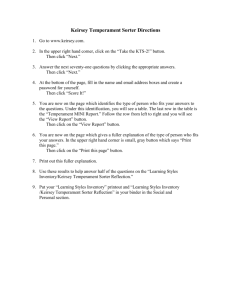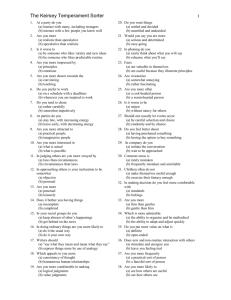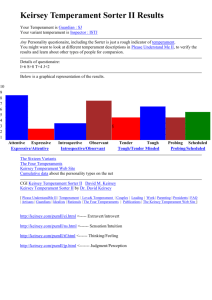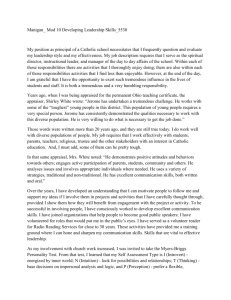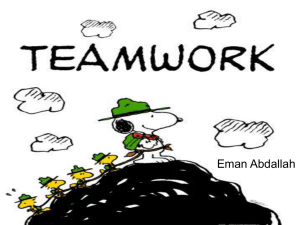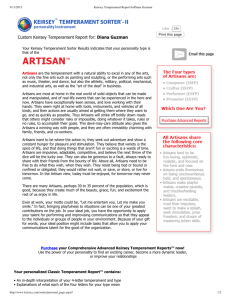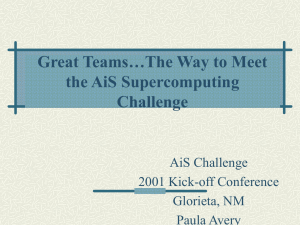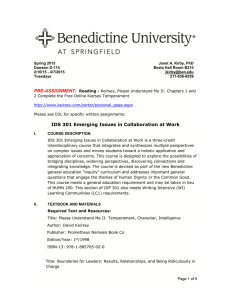Name: Dawn Deming. Personal Assessment Paper Date: June 6
advertisement
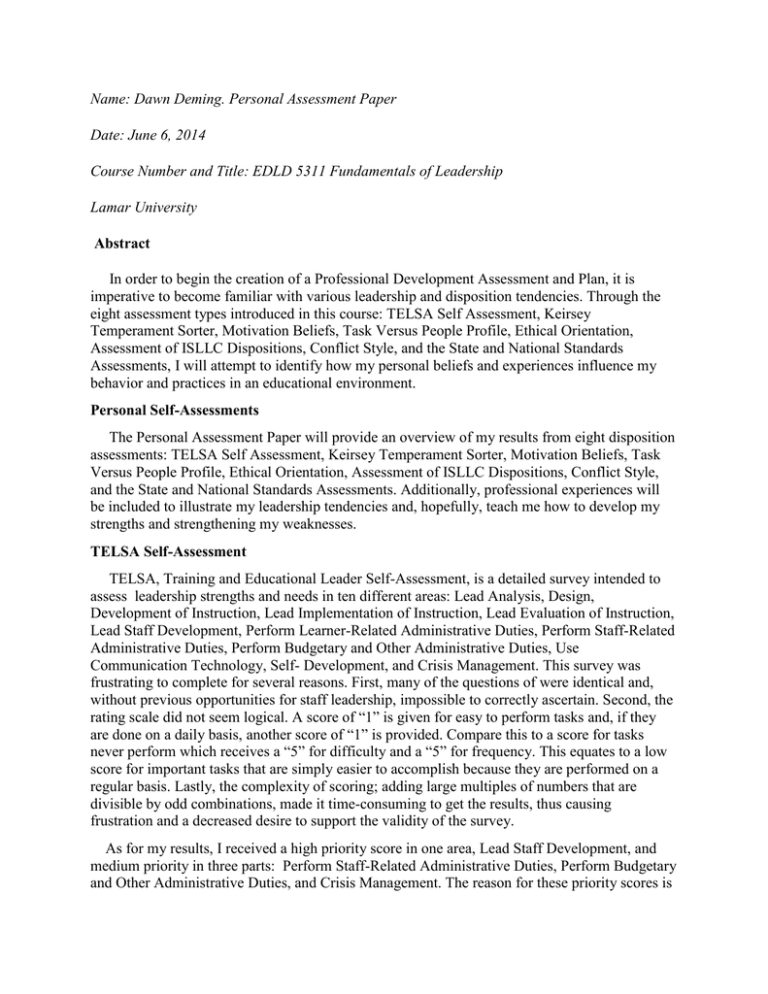
Name: Dawn Deming. Personal Assessment Paper Date: June 6, 2014 Course Number and Title: EDLD 5311 Fundamentals of Leadership Lamar University Abstract In order to begin the creation of a Professional Development Assessment and Plan, it is imperative to become familiar with various leadership and disposition tendencies. Through the eight assessment types introduced in this course: TELSA Self Assessment, Keirsey Temperament Sorter, Motivation Beliefs, Task Versus People Profile, Ethical Orientation, Assessment of ISLLC Dispositions, Conflict Style, and the State and National Standards Assessments, I will attempt to identify how my personal beliefs and experiences influence my behavior and practices in an educational environment. Personal Self-Assessments The Personal Assessment Paper will provide an overview of my results from eight disposition assessments: TELSA Self Assessment, Keirsey Temperament Sorter, Motivation Beliefs, Task Versus People Profile, Ethical Orientation, Assessment of ISLLC Dispositions, Conflict Style, and the State and National Standards Assessments. Additionally, professional experiences will be included to illustrate my leadership tendencies and, hopefully, teach me how to develop my strengths and strengthening my weaknesses. TELSA Self-Assessment TELSA, Training and Educational Leader Self-Assessment, is a detailed survey intended to assess leadership strengths and needs in ten different areas: Lead Analysis, Design, Development of Instruction, Lead Implementation of Instruction, Lead Evaluation of Instruction, Lead Staff Development, Perform Learner-Related Administrative Duties, Perform Staff-Related Administrative Duties, Perform Budgetary and Other Administrative Duties, Use Communication Technology, Self- Development, and Crisis Management. This survey was frustrating to complete for several reasons. First, many of the questions of were identical and, without previous opportunities for staff leadership, impossible to correctly ascertain. Second, the rating scale did not seem logical. A score of “1” is given for easy to perform tasks and, if they are done on a daily basis, another score of “1” is provided. Compare this to a score for tasks never perform which receives a “5” for difficulty and a “5” for frequency. This equates to a low score for important tasks that are simply easier to accomplish because they are performed on a regular basis. Lastly, the complexity of scoring; adding large multiples of numbers that are divisible by odd combinations, made it time-consuming to get the results, thus causing frustration and a decreased desire to support the validity of the survey. As for my results, I received a high priority score in one area, Lead Staff Development, and medium priority in three parts: Perform Staff-Related Administrative Duties, Perform Budgetary and Other Administrative Duties, and Crisis Management. The reason for these priority scores is the fact that, as a classroom teacher, I have not been provided the chance to facilitate many of these components. Therefore, it is challenging to accept that I would not be able to successfully perform these duties. In conclusion, I am not convinced these areas are weaknesses, but rather subjects with limited exposure, and this survey should be retaken when I have further leadership experience. Keirsey Temperament Sorter Score: Idealist I was concerned about my rating in this assessment tool because I have the inclination to be overly concerned with the temperament of others, which some have hinted is a weakness as a leader. However, when I read the summary of my type, Idealist, I realized this predisposition can sometimes be a strength. It stated on the Kiersey website that “Idealists are sure that friendly cooperation is the best way for people to achieve their goals” and they are “…passionately concerned with personal growth and development”. These observations describe the structure of our monthly art department meetings. In these meetings, we make sure each person has the opportunity to share their opinions and participate in events that are important to them. As a result, people feel respected and it has increased individual “buy-in” for our reformed art focus vision. The fact that Gandhi, Oprah Winfrey, and Mark Twain were identified as Idealists further illustrates how this style of leadership could be an asset. Motivation Beliefs Before reading the section on motivating and developing others, I thought about my personal motivators as well as stimulating experiences in the classroom. I have always believed that if something has intrinsic worth, or it is relevant to one’s life, one will be encouraged to pursue and master it. External rewards or consequences have never seemed to work for long-term goals. For example, I had a problematic double period class in which the students would be focused for around thirty minutes then I had to work to keep them motivated the remaining hour. It did not matter if the assignment was experiential, multi-sensory, or kinesthetic, the students could not stay on task. It was not until I switched the application of the skills to their real-life situations; value painting studies explored through airbrushing or duct tape fashion, that their attitudes and efforts changed. Three motivational theories I subscribe to are Vroom’s Expectancy Theory, Bandura’s Social Cognition Theory, and the Goal Theory of Motivation by Ames, Maehr, and Midgley. Expectancy Theory involves a mathematical formula of three components that must be present for motivation to occur: (expectancy of the event) x (connection of success to reward) x (value of a goal). One way this method could be used is to motivate faculty members to follow behavioral procedures. If they knew that completion of behavioral plans could result in less classroom interruptions (expectancy), that their completed forms would reduce workload (reward), and students would receive the consequences of their actions (value), they might be more likely to complete the required paperwork. Social Cognition Theory; belief that your regulated efforts will be successful, also has many practical applications for motivation. For example, if I am given the opportunity to select my duty days and times, I can create a schedule that is workable with my other demands and might be less likely to miss or forget my duty obligations. Finally, the Goal Theory of Motivation recognizes there are two types of goals, task goals and ability goals. If a learner focuses on task goals, their motivation to learn increases. As a staff member, this would be beneficial when presented with new data to implement in a curriculum. Too often, data is provided and people are expected to interpret it (ability goal). As a result, people rely on the “expert” of the staff to tell them what to do. If they were asked to summarize one section of the data (task goal) then present it to the staff, all members would have a reason (motivation) to participate. Task Versus People People: 14 Task: 21 I was surprised that I didn’t receive a higher “people” score as I can be overly concerned with others’ opinions and feelings, as is evident in my Kiersey score. My task versus people score was reinforcing in some ways because it is crucial that educators remain focused on the goal of our job- creating lifelong learners- and not lose sight of the forest for the trees. This score also reminded me about several times I did not represent departmental beliefs in our leadership meetings because they were not compatible with the mission of the school. For instance, one situation involved the scheduling of classes; art teachers wanted total control over their preparation time and duty schedules. Yet, this demand was not compatible with part-time employee and extracurricular schedules. This meant I had to concede this point in the meeting as it did not support the greater goal. Therefore, this score does reflect my tendencies to sometimes choose the task over people and perhaps a better balance needs to be established. Ethical Orientation Highest: Socially Aware I found this assessment tool problematic to complete as there were several equally viable answers for each case study. My scores in the organizational and idealistic areas were extremely close to my score in the socially aware component. These close scores show that I value fairness and believe that fair is not always equal. For this reason, I decided to focus on my lowest score; economic. As a career educator, the only time I am concerned about money is regarding my classroom supply budget. This concern occurs twice a year as opposed to being a top priority I am handling on a weekly basis. Furthermore, staff involvement with finances is not usually an area that supervisors ask a facility members to assist. I would be interesting in re-visiting this assessment tool after I begin working with school accounting records and interpreting allotment of funds to determine if my highest score stays the same. Assessment of Dispositions For this form, I requested my principal to complete it so I could compare the answers. We had almost identical results, which caused a feeling of reassurance that I am not distorting my actions. The areas of growth for me include using a communication style appropriate to the setting and audience and embracing technology as a resource to support learning. In regards to the first concern, my principal explained that sometimes I use educational terminology and reference theories that are not commonly known by parents. He suggested that I provide a handout for reference or verbally explain that ideas when speaking with parents and guardians. The second area, technology, is more a matter of availability. In the past two years, I have volunteered for every IT (Information Technology) opportunity the district has offered. Incorporating new software and devices had not being possible in a school of 600 students with only two computer labs and no traveling laptops. Consequently, the accessibility hinders my ability to embrace this tool to support learning. To address this problem, I plan on continuing to enroll in courses, apply for grants, and reach out to the community for solutions. Conflict Style High: Harmonizing/ Integrating Low: Forcing These totals emphasized previous scores in the other assessment surveys and were not a surprise for me to discover. As shown in the Keirsey Temperament Sorter and Task Versus People, I have a “high concern for people, feelings and smooth working relationships”; conflict is something I tend to avoid. It was comforting to learn that I also scored high in integration because there needs to be a balance between relationships and goals. For example, when I served on the district materials adoption committee, many different departments wanted their needs to be acknowledged but there were limited resources to allocate. We had to listen to the requests, weight their importance and absorption in the system, and then create a formula to disperse reserves that would lead to better use of the funds in terms of learning. This was not a task that could have been accomplished if we exhibited a forcing conflict style. State and National Standards Assessments As with the TELSA Self- Assessment, I did not find this inventory to be an accurate representation of my abilities as many of the descriptions were vague, not applicable to my current job, and dependent on individual district goals. My areas of strength were integrity and ethics, curriculum, measurement, and alignment of resources, and campus culture and professional learning. My areas of need include budgeting, resource allocation, and financial management, and staff evaluation and development. At this time, I am not comfortable ranking one domain over another with regard to school leadership. It seems to me that the district goals should drive the importance of these areas as well as school management and job descriptions. An illustration of this point would be a school where a safety committee is already in place and the school leader simply needs to oversee its implementation. Or a school that has statemandated teacher evaluations and accountability assessments, such as Colorado, in which the principal’s primary responsibility is to inform, train, and support staff members with these tools. At this point in the principal licensure program, I am unable to develop a hierarchy of goals without knowing the school’s strategic plan. Martin, G. E. (2005). School leader internship: Developing, monitoring, and evaluating your leadership experience: Meeting ISLLC, NCATE, and ELCC standards. Larchmont, NY: Eye On Education. Personality Test- Keirsey Temperament Website. (n.d.). Retrieved June 5, 2014 from http://www.keirsey.com Personality Test - Keirsey Temperament Website. (n.d.). Retrieved June 5, 2014, from http://www.keirsey.com/.
